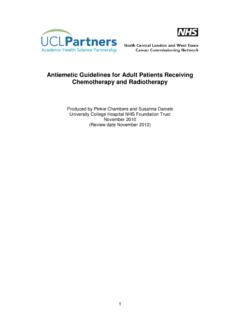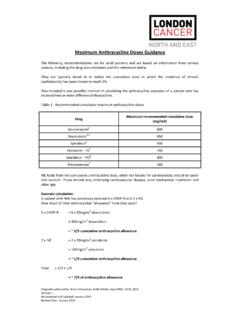Transcription of Dosage Adjustment for Cytotoxics in Renal Impairment
1 Dosage Adjustment for Cytotoxics in Renal Impairment .. January 2009.. Dosage Adjustment for Cytotoxics in Renal Impairment This table is a guide only. Pharmacokinetic, Summary of Product Characteristics (SPC), relevant pharmaceutical company data and various references have been reviewed for each drug. From this information, a recommendation has been suggested. Input of the full clinical picture of the patient should always be taken into account. As limited data is available, the scope of the document applies to adult data. If paediatric data is obtainable, this has been included. If a patient is following a specific clinical trial or protocol, it is advisable to follow the associated dose modifications.
2 The BNF (Edition 59) states (from Chronic kidney disease in adults: UK guidelines for identification, management and referral (March 2006): Degree of Impairment eGFR mL/ (GFR = eGFR x ). Normal More than 90 (with other evidence of kidney damage). Mild 60 89 (with other evidence of kidney damage). Moderate 30 59. Severe 15 29. Established Renal failure Less than 15. Drug Pharmacokinetics Available Information Recommendation Alemtuzumab t1/2 23 30 hours. SPC (Bayer 2008) No studies have been conducted in patients with Renal Clinical Decision Serum concentration rise Impairment . corresponds with reduction in Schering Unlikely to require a reduction.)
3 Cleared intracellularly. Treatment malignant lymphocytosis. Different is not recommended. pharmacokinetic properties may be BC Cancer Agency No information found. related to different tumour burden and distribution. Alemtuzumab is primarily metabolised intracellularly. Amsacrine Amsacrine is extensively SPC (Goldshield 2007) for patients with impaired Renal function, reduce dose If CrCl < 60ml/min, reduce dose by metabolised in the liver. The by 20-30% (to 60-75mg/m2 per day). 25%. principal metabolites, via BC Cancer Agency Reduce dose by 25% if serum creatinine is >140 mol/L. microsomal oxidation, are much AML 17 - If Renal function is reduced (Cr Cl < 60ml/min) the dose should be more cytotoxic than the parent reduced by 25%.
4 Drug. Excretion is via the bile. Dialysis >50% excreted in faeces within 2 Renal Drug Handbook - CAPD, HD, HDF/High flux, CAV/VVHD - Dose as hours; 35% in urine. in Renal Impairment 60-75mg/m2 daily. UCLH - Dosage Adjustment for Cytotoxics in Renal Impairment (Version 3 - updated January2009) Page 2 of 24. Drug Pharmacokinetics Available Information Recommendation Arsenic Trioxide Arsenic is stored mainly in liver, SPC (Cephalon 2008) Safety and effectiveness of arsenic trioxide in patients Clinical decision consider dose kidney, heart, lung, hair and nails. with Renal Impairment have not been studied. Caution is needed in patients with reduction in GFR<30mls/min.
5 Trivalent forms of arsenic are Renal Impairment as this is the main route of elimination. methylated in humans and mostly Cephalon A phase I, multicentre, open label, non-randomised study of arsenic excreted in urine. trioxide injection was performed to establish the safety of the drug in patients with Renal Impairment . Twenty patients with varying Renal function were included. Patients that had severe Renal dysfunction (GFR<30mls/min) had a mean AUC value 48% greater than patients with normal Renal function. Systemic exposure to metabolites of arsenic trioxide was also greater in the renally impaired groups of patients. No increased toxicity was noted but the clinical consequences were unknown.
6 Toxicity profile across all groups of Renal Impairment was similar. ATRA (tretinoin) After an oral dose of radiolabelled SPC (Roche 2008) due to limited information on patients with Renal Reduce dose to 25mg/m2 in Renal tretinoin, about 60% of the insufficiency, reduce dose to 25mg/m2 as a precautionary measure. Impairment . radioactivity was excreted in urine BC cancer agency as above. and about 30% in faeces. The metabolites found in urine were formed by oxidation and glucuronidation. Azacitadine Azacitadine undergoes rapid Pharmion Recommended starting dose is 75mg/m2 SC daily for 7 days. No No dose reductions necessary for 1st elimination. The route of dose Adjustment of initial dose based on Renal function is recommended.
7 If cycle. elimination requires further study. unexplained reductions in serum bicarbonate or elevations in serum creatinine, The drug appears to undergo or BUN occur, the Dosage should be reduced by 50% on the next course. The metabolism. Excretion of start of the next cycle should be delayed until values return to normal. unchanged drug and metabolites is via the kidneys. The activity of metabolites is unknown. Bevacizumab Terminal half-life 19-20 days SPC (Roche 2008) Safety and efficacy has not been studied in this group of Clinical decision patients Roche preclinical studies in animal models indicated no adverse effects in Renal dysfunction.
8 Dialysis Inauen et al reported a case where bevacizumab was well tolerated with haemodialysis without a dose reduction1. Renal Drug Handbook bevacizumab has been used in a haemodialysis patient at a dose of 5mg/kg every 14 days. Bexarotene Metabolised by oxidation via SPC (Cephalon 2007) No formal studies have been performed in this group Clinical decision unlikely to require CYP450 3A4 and glucuronidation. of patients. Renal excretion is not a significant elimination pathway. reduction unless severe Renal Less than 1% excreted in the urine. Impairment . UCLH - Dosage Adjustment for Cytotoxics in Renal Impairment (Version 3 - updated January2009) Page 3 of 24.
9 Drug Pharmacokinetics Available Information Recommendation Bleomycin t 2-4 hours. SPC (Mayne pharma) If creatinine 177-354 mol/L, give 50% dose. If CrCl (ml/min) Dose Rapid distribution to body tissues creatinine >354 mol/L, further reduction is necessary. The rate of excretion is (highest concn in skin, lungs, highly influenced by Renal function; concentrations in plasma are greatly >50 100%. peritoneum & lymph). Inactivation elevated if usual doses are given to patients with Renal Impairment with only up 10-50 75%. takes place primarily in the liver. ~ to 20% excreted in 24 hours. Observations indicate that it is difficult to <10 50%. 2/3 of drug is excreted unchanged eliminate bleomycin by dialysis.
10 In the urine, probably by glomerular Kyowa Hakko As above and bleomycin should be used with caution in filtration. patients with significant Renal Impairment as clearance may be reduced and toxicity increased. NB when GFR ~<30ml/min patient may be at increased risk of developing lung dysfunction. Faulding suggested dose modification schedule: CrCl 10-50ml/min 75%. dose. CrCl < 10ml/min, give 50% dose. Renal Drug Handbook GFR 20-50mls/min - dose as in normal Renal function, 10-20mls/min give 75% of dose, <10mls/min 50% of normal dose. Dialysis Renal Drug Handbook CAPD, HD, HDF/High Flux 50% dose. CAV/VVHD 75% dose. Bortezomib Metabolised by oxidative SPC (Janssen Cilag 2008) The pharmacokinetics of bortezomib are not Clinical decision consider reduction debronation via CYP450 3A4, influenced in patients with Renal Impairment (CrCl> 20 ml/ m2); if GFR<20mls/min 2C19 and 1A2.





